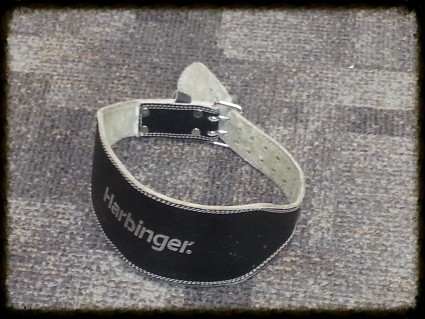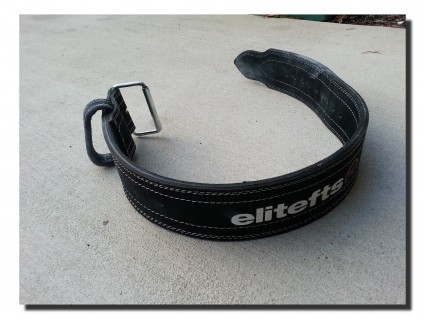Weight Belts, they’re Totally Misunderstood.
Some research says:
Weight Belts Don’t Work. <—-but this is mostly in occupational settings and has, for reasons I can’t understand been extrapolated to the athletic performance arena.
Some, most, research says:
Yes, They Do.
Here’s a really nice research review, kinda old, but still pretty good.
And that dude at the gym, the guy with the jorts and sweet rat-tail, he’s always wearing one.
But he’s a total tool,
The HUGE guy who deadlifts 5 plates for reps, he uses one too.
And he’s the strongest guy there….
So what’s the deal?
The deal is:
Straight Fact.
First off, these things:
They do Little to Nothing.
Except give you a false sense of support.
Yeah you might get some support, especially if you’re max squat is around 135lbs.
But if you’re cranking up serious weights, that aint gonna do jack.
These:
can be a very valuable tool IF you use it correctly.
How to Use Weight Belt 101:
Push out Into the Belt.
Wearing abdominal belts raises intra-muscular pressure of the erector spinae muscles and appears to stiffen the trunk. Assuming that increased intra-muscular pressure of the erector spinae muscles stabilizes the lumbar spine, wearing abdominal belts may contribute to the stabilization during lifting exertions.- Miyamoto
Seriously,
that’s it,
that’s what matters.
Creating more Intra-Abdominal Pressure.
The major mistake that most people make with belts is that they believe the belt is there to provide them with “support”.
As in, the belt should support the low back/ core so you don’t have to do anything but put it on, crank it down and hope it holds you together.
But they don’t work best that way.
Sure you’ll get some support but you’ll also be cranking the hell out of your low back in the process.
What You Should Do:
Take in a deep diaphragmatic belly breath.
No, deeper, and make a bigger belly.
Think about filling your stomach cavity with as much air as possible and pressing your core out in ALL directions, not just to the front.
Here’s a Good way to test Yourself:
Wrap your hands around your waist, just up from your belly button and below the ribcage.
This is usually where a weight belt sits.
Now, take in a giant breath, pull it deep into your belly and actively try to push out against your hands in ALL directions.
THAT, my friends is what should happen.
You should be taking in a big, deep, breath, expanding the diagram and core in all directions.
The belt, if worn correctly, acts as an active “brace” for the core,
pushing back on you as you actively push into it.
It’s exactly like holding yourself in a doorway, or successfully navigating the Jumping Spider obstacle on American Ninja Warrior.
My dad would have kicked my azz.
Not so Random, Random Thoughts on Belts:
Louie Simmons used to say leave the belt one notch loose. <—-I have no clue if he still does.
Leave enough room that you could put your hand between the belt and you.
This way you could really push out hard into the belt, without it feeling like it was going to cut you in half or the belt restricting the abs from flexing.
Belts do allow you to lift heavier weights.
That said:
#1: A belt will not make a weak person strong.
#2: A belt will allow a strong person to train heavy in a safer manner more often.
When and How:
For the most part, keep the belts out of warmups, work up weights and rep work.
I tend to recommend belts for anything that is a 85-90% of 1Rep Max and above.
I think using a belt too frequently makes most people reliant on them and will detrain your ability to train without one. <—probably mostly psychological.
I also think that NOT using a belt frequently enough will detrain your ability and technique (pushing out into the belt is different from bracing the core), so you should use one occasionally, if you’re going to use one at all.
Belts and Reps:
Generally, for rep work, I think they should be left off (unless it’s heavy, 85%+ reps work).
But even at 80% and below, if the set is an all out, rep max, this is gonna really suck monkey ballzzz set, I would use a belt.
At some point fatigue sets in and it’s difficult to maintain technique, in fact, at some point it’s nothing more than
“Self Preservation”
If using the belt can maybe help save me from myself in this rare instance….
It’s going on.
But, the belt shouldn’t be relied on.
In this instance, under severe fatigue, the belt may be that extra 2% on the lift you probably shouldn’t have attempted, that MIGHT help you come out unscathed.
If you have poor technique, poor activation patterns and rely on it…..
You’re Screwed.
Be smart, if you’re going to start using a belt make sure it’s the real deal and not some piece of S.
Chances are, if you bought a belt in the store and it says Weider or Valeo on it and not Inzer, Elitefts, Rogue, Spud (there are lots others, but you wont find them in Dick’s) etc, and doesn’t need to be broken in, it’s a piece of junk.
Throw it away.
Make sure you’re using it properly.
But mostly, make sure you have good technique, movement and activation.
Your back depends on it.
Not missing work, depends on it.
Not hobbling around for a week depends on it…..





[…] a word on belts… […]